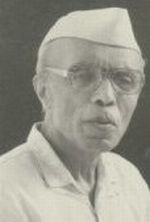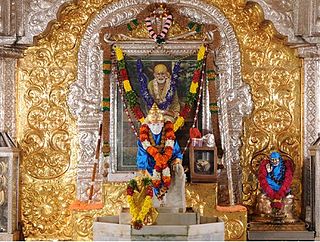This article's tone or style may not reflect the encyclopedic tone used on Wikipedia.(March 2022) |
Narayana Kasturi (25 December 1897 – 14 August 1987) [1] [2] was an Indian writer, professor, and journalist.
This article's tone or style may not reflect the encyclopedic tone used on Wikipedia.(March 2022) |
Narayana Kasturi (25 December 1897 – 14 August 1987) [1] [2] was an Indian writer, professor, and journalist.
Kasturi Ranganatha Sharma was born in Tripunithura in the Indian state of Kerala. [2] [3]
Kasturi received his bachelor's degree in law, and his master's degree in arts from the University College, Trivandrum, India. [3] After his degree at the age of 21, he gained a lecturer position in a high school in the city of Mysore. [2] After a few years, Kasturi began to "seriously contemplate on a career in Law." [2]
He received his bachelor's degree in law and master's degree in arts from the University College in Trivandrum. After completing his education, he worked as a lecturer in a high school in Mysore and later as a lecturer in Maharaja's College of Arts. [2] He also served as the Secretary of the Sri Ramakrishna Mission in Mysore for over 17 years. [3] During this time, he came into contact with various spiritual leaders and was initiated into Japam. In 1948, he met Sathya Sai Baba in Bangalore and was requested by Baba to write his biography, which he agreed to and later published as "Sathyam Sivam Sundaram Part I". [4] He later became the editor of the magazine of the Sathya Sai Organization called "Sanathana Sarathi."
In 1949, a University Order appointed Kasturi as the Principal of the Intermediate College in Davangere. [2] He held the position for five years before retiring in 1954. [2] After retirement, he was suggested by Sathya Sai Baba to go on a spiritual pilgrimage to North India with his mother and wife. [2]
In 1956, Sathya Sai Baba convinced Kasturi to accept the position of Producer of Programmes for the newly established All India Radio Station in Bangalore. [2]
Kasturi enjoyed the post and during a visit in 1958, Sathya Sai Baba suggested he work at Puttaparthi and start a monthly magazine called Sanathana Sarathi. Kasturi was responsible for ensuring the magazine was flawless and reached readers on time, with the help of volunteers. [2] The process of typesetting, printing, collating, stapling, packing, and addressing was done by hand, and was seen as a labor of love for Sathya Sai Baba. [2]
Kasturi died at the age of 89 on August 14, 1987 at Sathya Sai General Hospital in Puttaparthi due to natural causes. [5] His cremation took place on the banks of the Chitravathi River the following day. Upon his death, a mourning period was declared in Puttaparthi by Sathya Sai Baba, including the closure of Prasanthi Nilayam and other institutions. Kasturi's wife, Rajamma, had died in 1985. [5]
Kasturi authored the work 'Sathyam Sivam Sundaram', [6] which was translated into English as 'Truth, Goodness, Beauty'. The first part of the book was published in 1960 [7] [8] and covers the first 34 years of the life of Sathya Sai Baba. Kasturi stated that he gathered information for the book from various sources, including Sathya Sai Baba's father and brother, as well as teachers from the schools he attended. The second part of the book was published in 1968, and the complete work was published around 1980. [9] Kasturi stated that a significant amount of time had passed between the publication of certain parts of the book.
Narayana Kasturi was a writer and journalist who wrote for the magazine Koravanji in the 1940s and 1950s. He was known for discovering and promoting the work of young writers, including Kefa, Bulla, Aa. Ra. Se, Na. Kasturi, C.K.N. Raja, Girani Ramsami, and T. Sunandamma. Koravanji was successful during its publication but ceased in 1967 due to financial constraints. [10] Kasturi also wrote hagiographic accounts of Sathya Sai Baba's life and his own autobiography, [11] [12] [13] entitled "Loving God: Eighty-five Years under the Watchful Eye of the Lord" was published in 1982 by Sri Sathya Sai Books and Publications. [14] [12]

Sathya Sai Baba was an Indian guru and philanthropist. At the age of 14, he said he was the reincarnation of Shirdi Sai Baba and left his home saying "my devotees are calling me, I have my work."

Puttaparthi is a municipality and district headquarters of Sri Sathya Sai district of the Indian state of Andhra Pradesh. It is located in Puttaparthi mandal of Puttaparthi revenue division. The original name of Puttaparthi was Gollapalli. The town is located on the banks of Chitravathi River which is a tributary of Penna River, and is surrounded by undulating hills. It is widely known for the birthplace and deathplace of the Indian spiritual leader and guru Sathya Sai Baba and his ashram, Prasanthi Nilayam.

Prasanthi Nilayam is the main ashram and Samadhi Mandir of Sathya Sai Baba located in the town of Puttaparthi in, Sri Sathya Sai district Andhra Pradesh, India. Sathya Sai Baba was born in Puttaparthi. "Prasanthi Nilayam" means literally "Abode of the Highest Peace." Sathya Sai Baba gave daily darshan to his devotees in this ashram. Sathya Sai Baba was usually present in Prasanthi Nilayam from early June to the middle of March.

Whitefield is a suburb of Bangalore in the state of Karnataka, India. Established in 1882 as a settlement for the Eurasians and Anglo Indians of Bangalore, Whitefield remained a quaint little settlement at the eastern periphery of Bangalore city till the late 1990s when the local IT boom turned it into a major suburb. It is now a major part of Greater Bangalore. Whitefield is Bengaluru's first tech corridor to be connected by Namma Metro.

H. (Hanumanthappa) Narasimhaiah ; 6 June 1920 – 31 January 2005) was an Indian physicist, educator, writer, freedom fighter and rationalist from Karnataka. Publicly known as "HN", he was the Vice-Chancellor of Bangalore University and the president of the National Education Society. He was conferred the Padma Bhushan award by the Government of India in 1984.

Vinayaka Krishna Gokak, abbreviated in Kannada as Vi. Kru. Gokak, was an Indian writer in the Kannada language and a scholar of English and Kannada literatures. He was the fifth writer to be honoured with the Jnanpith Award in 1990 for Kannada language, for his epic Bharatha Sindhu Rashmi. Bharatha Sindhu Rashmi deals with the Vedic age and is perhaps the longest epic narrative in any language in the 20th century. In 1961, Gokak was awarded the Padma Shri from the Government of India for Dyava Prithvi.

Manepalli Narayanarao Venkatachaliah was the 25th Chief Justice of India. He served as Chief Justice from 1993 to 1994. He currently serves as the Chancellor of Sri Sathya Sai Institute of Higher Learning and on the Advisory Board of Foundation for Restoration of National Values, a society established in 2008 that strives to restore National and Cultural Values of India.
Sri Sathya Sai Airport is located at Puttaparthi in the state of Andhra Pradesh, India. The airport is named after Sathya Sai Baba, a spiritual guru and philanthropist. It is a small airport with facilities for chartered flights rather than commercial aircraft. The airport was inaugurated in 1990 to serve the Sri Sathya Sai Institute of Higher Medical Sciences during emergency situations. The airport's 1000-metre-long airstrip and terminal building were constructed by L&T ECC. The runway was later extended to enable the operation of larger jet aircraft.
The Sathya Sai Baba movement is a new religious movement inspired by South Indian Neo-Hindu guru Sathya Sai Baba who taught the unity of all religions. Some of his followers have faith in his claim to be a purna Avatar of Shiva and Shakti, who is believed to have been predicted in the Bhagavad Gita. This means that some of his followers see him as a God. Devotees engage in singing devotional songs called "bhajans" and selfless service (seva). Its official organization is the Sathya Sai Organization. However the Sathya Sai Baba movement extends beyond the organization. An important aspect of the faith of adherents is the miracles attributed to Sathya Sai Baba. The number of adherents is estimated between 6 and 100 million.

Prafullachandra Natwarlal Bhagwati was the 17th Chief Justice of India, serving from 12 July 1985 until his retirement on 20 December 1986. He introduced the concepts of public interest litigation and absolute liability in India, and for this reason is held, along with Justice V. R. Krishna Iyer, to be a pioneer of judicial activism in the country. He is the longest-served supreme court judge in India.
On June 6, 1993 there was an assassination attempt on Sai Baba's life. While reports vary, the official narrative is that four men (devotees) entered Sai Baba's residence under the premise of wanting to give him a telegram. When their path was obstructed, they stabbed two of the Baba's assistants to death, injuring two others. Hearing the commotion Sai Baba sounded the alarm and police were dispatched to his residence. Upon arriving, the police said the four youths had locked themselves in Sai Baba's living room and the officers tried to break the door down. "The four were shot when they opened the door and attacked the police." Sai Baba remained unharmed during the incident, and later in a discourse cleared things up saying there was no bid on his life.
The Sri Sathya Sai Central Trust (SSSCT), is a registered public charitable trust founded in 1972 by Sri Sathya Sai Baba. Its humanitarian work includes drinking water projects, healthcare and education.
The Smt Eswaramma High School was inspired and initiated by Bhagawan Sri Sathya Sai Baba. In fond memory of His mother, Bhagawan Sri Sathya Sai Baba had inaugurated the Smt. Eswaramma High School on 20 July 1972.

Sri Sathya Sai Prasanthi Nilayam is a major railway station and is located around 8 km to the west of the pilgrim town of Puttaparthi in Andhra Pradesh, India. Puttaparthi is a renowned pilgrim center and the location of the ashram of Sathya Sai Baba. The station comes under the jurisdiction of Bangalore division of South Western Railways. It has four platforms and is situated on the line connecting Dharmavaram and Penukonda.

Sri Naga Sai Mandir is a Hindu temple dedicated to the Indian Spiritual Master Shirdi Sai Baba in Coimbatore in the Indian state of Tamil Nadu.

Chong Chiu Sen is a Malaysian-born Chinese Carnatic vocalist. He was an apprentice of Carnatic musician D. K. Pattammal who also adopted him as her god-grandson and named him Sai Madhana Mohan Kumar.

Sri Sathya Sai district is a district in the Indian state of Andhra Pradesh. Its headquarters is at Puttaparthi. It was formed on 4 April 2022 from parts of the erstwhile Anantapur district.

Ryuko Hira is a renowned investor, and philanthropist, President of HMI Hotel Group and Ora Group of companies in Japan, engaged in the investment, ownership, and development of real estate, hospitality, and tourism projects in railways, airports, seaports, and public transportation located in 31 cities in Japan. He plays a pivotal role in directing Japanese investments towards India and is a pioneer in establishing cooperation agreements between several Indian state governments and Japanese prefectures. Hira’s family has been engaged in business in Japan since 1918. As of 2018, Japan Times reports him being the largest single Indian investor in Japan with US$ 2.5 billion in investments and over US$10 billion in net worth. Hira was conferred with the prestigious Padma Shri Award in 2022 by the President of India for his contribution to trade and industry. He is also widely known for his involvement in Indo-Japan economic exchanges, promotion of Indian culture, and his devotion to Sri Sathya Sai Baba.